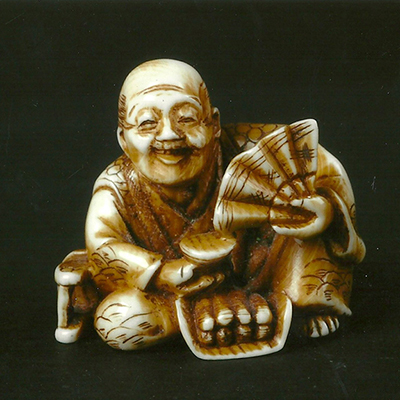I'm walking back along Drury lane passing the shops and cafes, the road bursting with vans, cars and cyclists and a dustbin lorry pushes up next to me. I pull myself away from the chaos and pause for a moment to look at a curtain of pink ballet shoes suspended from a shop window - then quickly along Museum Street, into Great Russell street and I arrive at the British Museum. This time I'm early and I wait in the room of Chinese ceramics. I'm making sure I don't miss out on the full two hour time slot. It will be busy in the study room today. There are also viewings for Japanese woodblock prints and a painted hanging scroll of a roaring tiger.
The Study Room
Lucy is looking after the study room today and has already put the box of netsuke on the table for when I arrive. Each one is carefully laid in tissue paper. She brings me a pair of blue plastic gloves, allowing me to handle the netsuke. I carefully pick out one of the standing horses which is curled round in the shape of a horseshoe. Head curved towards its front hooves, back arched with tail between its legs and front and back hooves touching making a natural hole for a toggle. I am able to see the netsuke from all angles and when I turn it upside down, delicately carved heels of the horses hooves are revealed. This standing horse is not made for standing but for hanging so I lay it down to draw. Lucy informs me that they have ways to stand the netsuke securely for photo shoots. This enables the photographer to get a good close up of a standing horse standing!
Horse Tales
It's only by drawing that I spend more time looking and become more present and these impossible postures remind me that these objects are the carver's interpretation. Was this netsuke carved from observing a real horse or from a collection of sketches or paintings or from memory? My drawing is an interpretation of the object and my carving will be another step removed like a visual game of Chinese Whispers until the final print will be something quite different to the original.
I put the standing horse back in its tissue paper and gently take 5 Horses into the palm of my hand. This netsuke of 5 Horses huddled together is less than 4cm in length and I'm not sure how to begin the drawing. There is so much detail in such a tiny space and when I turn the netsuke upside down, a jigsaw puzzle of tiny hooves surround the inscription of the carver's signature.
Time ticks quickly so I make two small sketches of the 5 Horses and move on to the Seated Horse with its head curled into its hooves. Sitting on its hind legs and back curved over onto its front legs reminds me more of how a dog would sit. It also reveals how little I know about the anatomy of a horse and I ponder for a moment - how does a horse sit?
I sketch the seated horse and then another standing horse with a bulbous muzzle and tail whipped around the side of its body pressing into its ribs. It's like a caricature of a horse and my drawing exaggerates this even more.
Finally I take the last netsuke from the box and make a drawing in the short amount of time I have left. If I was to view this netsuke only from underneath, the cluster of delicately carved hooves may give a clue that this is a protective mother Goat sheltering its Kid.












